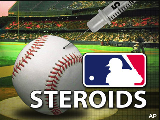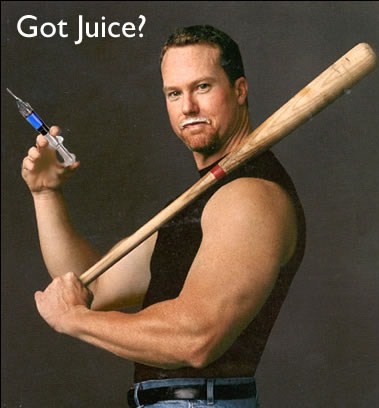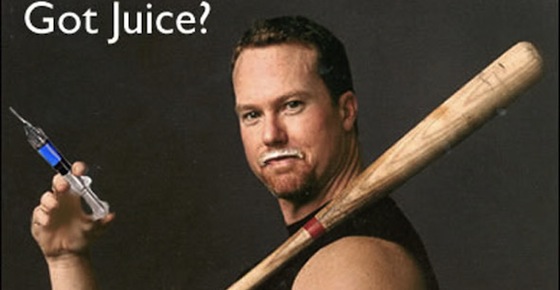
Major League Baseball had one of its most exciting seasons in 1998 when Mark McGuire and Sammy Sosa hit home runs at an astonishing pace. The whole country watched as McGuire hit number 62 to break Roger Maris' 37 year old single season record. McGuire eventually hit 70 and Sosa hit 66 that year, obliterating baseball's most cherished record. Then just 3 years later, Barry Bonds hit 73 homers to break the record again. Did anyone think something was fishy? It turns out that players were using performance enhancing drugs at an alarming rate. Why was it allowed to go on for so long? What do we make of the records that were broken and the players that broke them, now that we know that they were all cheaters?
Performance enhancing drugs, or steroids have been used by athletes for many years. The most common of the drugs were anabolic steroids. Steroids help an athlete gain muscle mass so they could become bigger and stronger and could train harder. Steroids also help an athlete recover from injuries more quickly. The short and long term side effects to steroid use are very dangerous, but athletes in their desire to win at all costs have used them regardless. In 1976 American swimmer Shirley Babashoff accused the East German swimmers of using performance enhancing drugs, as they came away with many of the medals Americans had been expected to win. It turns out that the entire East German team had been systematically on a drug program sponsored by East German government. Olympic sprinter Ben Johnson in 1988 won the 100 meter dash but was disqualified 3 days later when he tested positive for steroids. In football, evidence of doping dates back to the 1960s. Lineman Lyle Alzado who started his career in 1971 admitted to using anabolic steroids. The NFL banned the use of steroids in 1987 and started a testing program that would suspend players who violated the policy.
It stands to reason that baseball players would use performance enhancing drugs if they could get away with it. Baseball has a long history of cheating, with players taking amphetamines, stealing signs, throwing spitballs, and using corked bats. With the aid of steroids, power hitters could train harder and longer to build up more muscle, and that would mean more home runs. To pitchers, it would mean more speed on their fastballs. Older players would be able to extend their careers for a few more years. In the late 1980s and 1990s there were some rumors of players using steroids but nothing substantial.
Nothing turns off average sports fans like millionaires arguing with billionaires, but that's what the crippling strike of 1994 was about. After the playoffs and the World Series were, baseball needed some new excitement to bring back its fan base. In 1998, baseball got just what it needed as two likeable sluggers assaulted the most cherished of records, the single season home run record. In late August, as St. Louis Cardinal Mark McGuire and Chicago Cub Sammy Sosa banged homer after homer, the fans, the media, and the entire baseball world became fixated on Roger Maris' record of 61 home runs which would soon be obliterated. As the press followed McGuire's every move during the home run chase, a funny thing happened. Steve Wilstein, one of the writers following McGuire, noticed a bottle of something called "andro" in his locker. After some research, he found out that androstenedione was essentially artificial testosterone. It was an anabolic steroid, and McGuire confirmed that he'd been using it for over a year. It was banned in football and the Olympics, but there were no rules in baseball outlawing andro. Wilstein wrote his story on August 21 titled "Drugs Ok in Baseball, not Olympics." Wilstein was vilified. How dare he snoop around in McGuire's locker? How dare he write something negative when the great home run chase was going on?
McGuire and Sosa both broke the home run record in September. Baseball attendance soared. McGuire could have been crowned king of the baseball world. The money rolled in, and Commissioner Bud Selig was not about to start investigating steroid use, so Wilstein was the lone voice in the media suggesting perhaps something wasn't right. In the seasons that followed, rumors kept surfacing about players using banned substances. One player that wasn't happy about all the attention McGuire and Sosa got in 1998 was Barry Bonds. Bonds was already a sure Hall of Famer by 1999 but his game was a combination of speed, power, and all-around play. Starting in 1999, Bonds set out to match up with McGuire and Sosa on home runs as well. In 2001 Bonds showed up with a pumped up physique and starting hitting home runs with a vengeance. Bonds was a uniformly unpopular with the press and fans of every city except his hometown San Francisco, so his assault on the run record was not met with open arms in the baseball world. By season's end he'd hammered 73 home runs, breaking the record set just 3 years before. Even casual baseball fans knew something wasn't right, but no one wanted to deal with the "elephant in the room." There was no proof that any of the players were juiced. With no testing for steroids in place, there was no way to police the problem in baseball, if a problem really existed.
Bob Costas, a respected baseball broadcaster, suggested a number of times on the air that perhaps something funny was going on. In his interview for the Ken Burns "Baseball" documentary, he said:
I was trying in a general sense to call attention to the fact that this stuff just doesn't make sense. And this was the part that I found especially galling. People throughout baseball, who pride themselves on knowing the difference between the split second it took Bill Mazeroski to turn a double play as opposed to the average 2nd baseman, that pride themselves in knowing when a guy's arm angle comes down ever so slightly because he's fatigued in the late innings, who notice if a guy has moved half a step in or half a step back at 3rd base. They didn't notice a damn thing when guys showed up looking like they'd been inflated with bicycle pumps.
By 2002, Commissioner Bud Selig had been gathering information about steroids for a few years. He knew a plan of testing had to be implemented and that the players' union would not go along with it. He instituted a plan of testing in the minor leagues that would force players to be suspended if they tested positive, but to get the major leaguers to accept testing he'd have to crack the players' union. While the leadership of the union fought against any manner of testing, many players who were clean wanted action. Pitchers were getting tired of facing a new crop of bulked up supermen each season. Players were concerned that if they didn't take steroids their job would be taken by someone who did. In May, 2002 Jose Canseco, who had 467 home runs to his credit, announced his retirement and started telling the baseball world about the sordid underbelly of steroids. He admitted using steroids himself, said he'd never had made the major leagues without the drugs, and stated that 85% of players were on the juice. Canseco gained a lot of attention but no one took him seriously. Then in June an article came out in Sports Illustrated in which retired slugger Ken Caminiti admitted to steroid use during his career including his 1996 MVP year. Caminiti's claim was that half of major league players were on steroids. These claims and all the attention it caused continue the pressure on the player's union to agree to testing. Finally with the collective bargaining agreement expiring in 2002, testing for steroids was put into the new agreement, and the players and owners averted a strike for the first time in decades. They agreed to testing and suspension as part of the policy only if after an initial anonymous test proved that more than 5% of the players were using.
Drug testing and suspensions were instituted, but that wasn't the end of the story as players worked with sophisticated trainers and other shady characters who came up with new undetectable to try to beat the tests. One such character was Victor Conte, whose lab BALCO cooked up a couple of steroids "the clear" and "the cream" which when taken couldn't be detected by the urine tests administered to the players. Another drug was the human growth hormone, or HGH, which there was no urine test that could detect it. Conte's lab was eventually busted, and a number of players including Barry Bonds were implicated. It seemed that no player in this era was free from suspicion.
In 2005, Jose Canseco published his book "Juiced" in which he told of his experiences with steroids, and named several high profile players as steroid users. On March 17, 2005, Congress held a highly publicized hearing, with a number of players former and current being brought in to testify. Jose Canseco stated the same claims he had before, stating that a large percentage of players used steroids. Mark McGuire refused to answer questions, stating "I'm not here to talk about the past," while current player Rafael Palmeiro wagged his finger at the committee and stated "I have never used steroids, period." Barry Bonds, perhaps the most notorious user, was not asked to testify. In an ironic twist, 5 months after the hearing it came out that Palmeiro had tested positive for steroids and was suspended. Congress and the public were less than satisfied that steroids had been cleaned out of baseball. In November, 2005, the suspension times for positive tests were increased to 50 games for the first offense. This was finally a punishment that had a bite to it.
Since 2005 the story of steroids in baseball has taken many unexpected twists and turns.
- The book "Game of Shadows" was published, where evidence of the BALCO scandal are detailed and its connection with Barry Bonds. Bonds is later charged with perjury for lying to a grand jury.
- Barry Bonds passed Hank Aaron to break the all time career home run record. Barry Bonds is almost universally considered a liar and a cheater as evidence that he was a heavy steroid user is overwhelming.
- Former Senator George Mitchell is tasked with creating a report for baseball. After a 21 month investigation, the Mitchell report is delivered in December, 2007. In it, details of 89 players and their connection with performance enhancing drugs is brought out. One of the players accused is pitcher and 6 time Cy Young award winner Roger Clemens. Clemens denies all steroid use, and is later charged with perjury for lying under oath at a House committee hearing.
- On April 13, after a 12 day trial, Barry Bonds is convicted of 1 count of obstruction of justice, while the jury failed to convict him on the perjury charges. Bonds avoids a prison sentence and receives just probation for this conviction.
- On June 18, 2012 Roger Clemens is acquitted of all perjury charges. Clemens maintains he never used steroids and that all the evidence against him and all of the testimony from trainer Brian McNamee are lies.
- In 2012, MVP slugger Ryan Braun had his 50 game steroid suspension overturned on a technicality. Braun maintains his innocence.
- In 2013, Alex Rodriguez and a number of other players are hit with suspensions for involvement with a drug lab called Biogenesis. Alex Rodriguez is hit with a 211 game suspension which he appeals while the other players including Ryan Braun accept their suspensions.
Is the game of baseball cleaned up yet? Clearly not. Players are finding more sophisticated ways to cheat and get away with it despite the threat of suspensions. None of the players of this era whose names have been associated with steroids have come close to making the Hall of Fame. Mark McGuire, Sammy Sosa, Rafael Palmeiro, Barry Bonds, Roger Clemens, and many others whose credentials would put them easily in the Hall they're not even coming close to getting enough votes. McGuire has publically admitted his own steroid use. Palmeiro maintains his innocence and says the positive test was the result of a vial of vitamin B-12 given to him by a teammate. Clemens continues to claim that all the evidence against him was lies. We'll never know for sure with these players, but we do know that the temptation to cheat with performance enhancing drugs is great, with so much money at stake. Players want to put up home run numbers, get ahead of the next guy, and extend their careers as they get older, and unfortunately many are still willing to risk the suspension and risk the health hazards that go along with steroid use.










STILE A BUON MERCATO NIKE BLU UOMO
Does your site have a contact page? I’m having a tough time locating it but, I’d like to send you an e-mail. I’ve got some creative ideas for your blog you might be interested in hearing. Either way, great site and I look forward to seeing it develop over time.
MATT OSBER
Contact link is in the top right and bottom right of the page.
JOHNBUSH
Hello! Very good job(this site)! Thank you man.